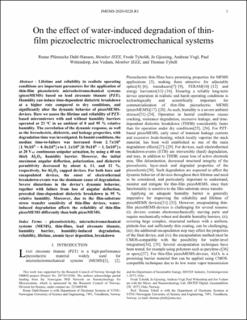Electrochemically driven degradation of chemical solution deposited ferroelectric thin-films in humid ambient
Dahl-Hansen, Runar Plunnecke; Polfus, Jonathan Marc; Vøllestad, Einar; Akkopru-Akgun, Betul; Denis, Lyndsey; Coleman, Kathleen; Tyholdt, Frode; Trolier-Mckinstry, Susan E; Tybell, Per Thomas Martin
Peer reviewed, Journal article
Accepted version
Permanent lenke
https://hdl.handle.net/11250/2994660Utgivelsesdato
2020Metadata
Vis full innførselSamlinger
- Publikasjoner fra CRIStin - SINTEF AS [5801]
- SINTEF Digital [2501]
- SINTEF Industri [1565]
Originalversjon
10.1063/5.0003989Sammendrag
The ambient humidity significantly accelerates the degradation of lead zirconate titanate (PZT) films in microelectromechanical systems; the cause of such degradation is under debate. Here, it is shown that the degradation of chemical solution derived PZT thin-films in humid conditions is driven by the system's electrochemical activity toward water electrolysis. The layer stacks with Pt-based electrodes exhibited a faster degradation rate owing to their higher electrocatalytic activity compared to Au. A degradation model is proposed based on the electrolysis of liquid or gaseous H2O, involving the evolution of oxygen and hydrogen gas at the top and bottom electrodes. Degradation proceeds above the threshold voltage for a given electrode system and is driven by the evolution and pressure build-up of gaseous species at the PZT/electrode interfaces. The pressure build-up causes film cracking, delamination of the film and electrodes, electrothermal breakdown events, and eventually time-dependent dielectric breakdown. Significantly larger post-breakdown crater sizes in humid than in dry conditions suggests that larger cracks through which dielectric breakdown through humidified air can occur. Overall, these effects are shown to cause sample failure up to six orders of magnitude of time earlier than for operation in dry conditions. Thus, in order to improve the resilience of thin-film systems in humid conditions, it is imperative to protect the electrochemically active electrode components of the device. ACKNOW
